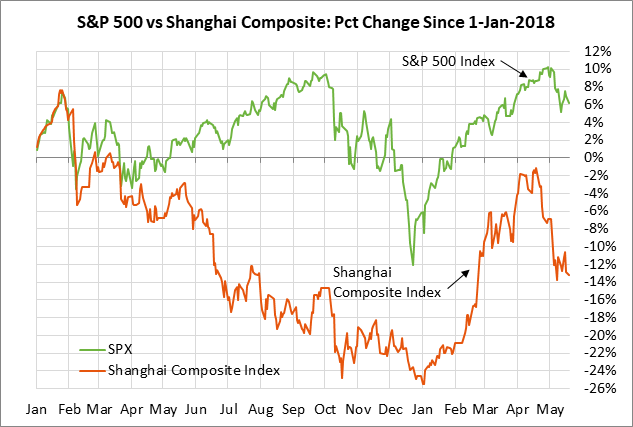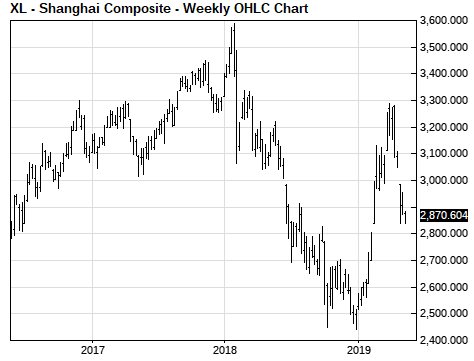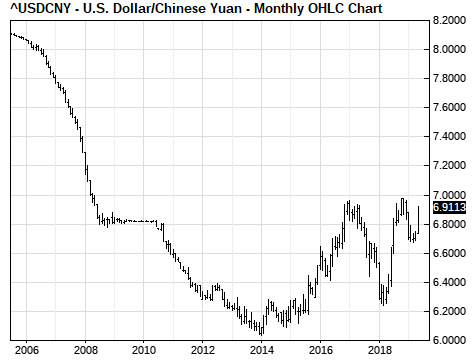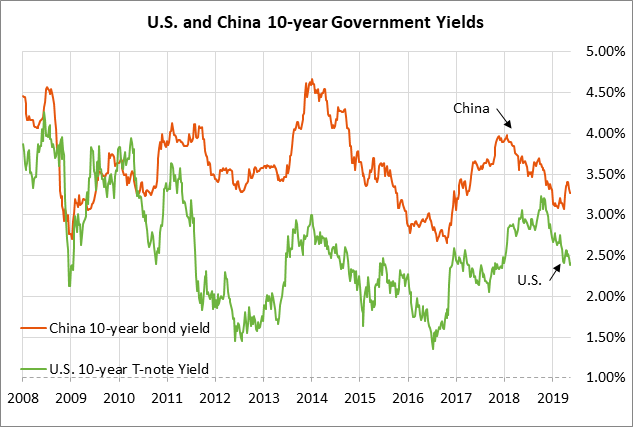- U.S. partially softens Huawei ban after quick fallout for U.S. companies and hardware
- A Chinese yuan break below 7 yuan/USD could spark capital flight and stock market sell-off
- U.S. existing home sales expected to improve with mortgage rates at 1-1/4 year low
U.S. partially softens Huawei ban after quick fallout for U.S. companies and hardware — The Trump administration late Monday announced that it had issued a license for three months for some U.S. companies to keep doing business with Huawei if those deals are “necessary to maintain and support existing and currently fully operational networks and equipment, including software updates and patches.” The administration apparently realized that some U.S. network operations, particularly rural broadband companies, could be hamstrung by last week’s full Huawei ban and thus decided to soften the ban. However, the ban still seems to prevent any new sales or purchases from Huawei.
The U.S. stock market on Monday took a hit after Google over the weekend cut off Huawei from some hardware and software services including its propriety Android operating system. In addition, chip companies such as Intel, Qualcomm, Xilinx and Broadcom reportedly told employees that they cannot sell any products to Huawei until further notice. China-based Huawei is the world’s largest networking gear manufacturer and the world’s second largest smartphone maker.
The markets are waiting to see if China will retaliate for the U.S. blacklisting of Huawei, which is China’s most important hardware technology company. Indeed, Chinese President Xi on Monday visited a rare earth mining company, which seemed to be an implicit threat that China could shut down the sale to U.S. companies of rare earth metals and minerals. China has many other avenues of retaliation such as hampering sales in China by large U.S. retailers in as Apple, Microsoft, GM, Ford, Chrysler, Nike, Coca-Cola, Procter & Gamble, McDonalds, Starbucks, Wal-Mart, KFC/Yum Brands, and many others.
Aside from the Huawei controversy, the markets are still waiting to see if the US/China talks will resume after Chinese state-run media last week indicated that Chinese officials have little interest in new talks. There has been no word on when Lighthizer/Mnuchin will travel to China for another round of trade talks. There has also been no definitive word on exactly when Presidents Trump and Xi might meet when they attend the G-20 summit on June 28-29 in Japan. There is little time to waste to try to get US/Chinese trade talks back on track after President Trump recently threatened to slap a 25% tariff on another $300 billion of China products as soon as mid-June if there is no trade agreement.
A Chinese yuan break below 7 yuan/USD could spark capital flight and stock market sell-off — The Chinese yuan on Monday closed slightly higher by +0.1% at 6.912 yuan/USD and barely held above last Friday’s 5-1/2 month low of 6.9207 yuan/USD. The yuan is only 1.0% above last November’s 11-year low of 6.9799 and is only 1.1% above the psychological level of 7 yuan/USD.
The Chinese yuan has sold off sharply by -2.6% against the dollar so far this month largely because of the collapse of a US/Chinese trade deal and President Trump’s hike in tariffs to 25% from 10% on $200 billion of Chinese goods. President Trump also threatened to slap a 25% tariff on another $300 billion of Chinese goods as soon as June, which would cause a significant hit to China’s economy. In response, the Chinese central bank has been providing targeted liquidity to the money markets, which is negative for the yuan’s interest rate differentials.
The Chinese 10-year government bond yield in May has so far fallen by -13 bp to the current level of 3.27%, which is just 1 bp above last Thursday’s 6-week low of 3.26%. By contrast, the 10-year T-note yield this month has fallen by only -8 bp to 2.42%, thus leading to a 5 bp deterioration of the Chinese bond yield differential against the U.S. T-note yield, which is of course bearish for the yuan.
The Chinese stock market is carefully watching the yuan since a new 11-year low or the breach of the 7 yuan/USD level would raise the hackles of the Trump administration and would likely make the US/Chinese trade relations even worse. In addition, further weakness in the yuan could spook the Chinese stock market due to fears of capital flight. The Chinese stock market plunged back in 2015 when Chinese officials unexpectedly allowed the yuan to depreciate, thus causing heavy capital flight before Chinese officials put even tighter restrictions on the outflow of yuan from China.
The Chinese yuan on Monday stabilized and closed slightly higher after Chinese officials set the yuan currency fix a little higher than expected. However, the yuan will likely see continued downward pressure as long as the Chinese economy remains under the threat of U.S. tariffs and trade-blacklisting of Chinese technology companies. Chinese officials will likely use their usual currency levers to prevent the yuan from falling below the 7 yuan level. However, if the 7 yuan/USD level is breached, then the Chinese stock market is likely to see further losses as the markets wonder whether Chinese officials will be able to contain the fall-out from the sharp deterioration in US/Chinese trade and business relations.
U.S. existing home sales expected to improve with mortgage rates at 1-1/4 year low — The consensus is for today’s April existing home sales report to show an increase of +2.7% to 5.35 million, partially reversing March’s -4.9% decline to 5.21 million. U.S. home sales saw weakness all last year as mortgage rates rose, but have perked up so far in 2019 and are only -7.6% below the 12-year high of 5.64 million units posted in November 2017. The 30-year mortgage rate is currently at a 1-1/4 year low of 4.07% and has plunged by -87 bp from last November’s 8-year high of 4.94%.





